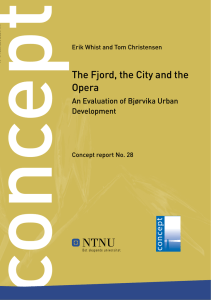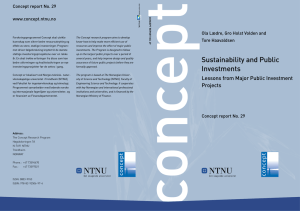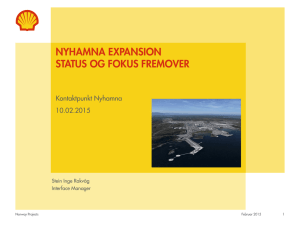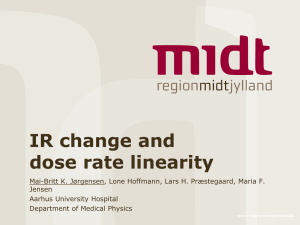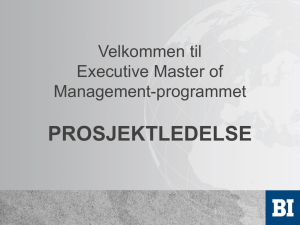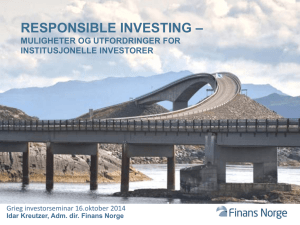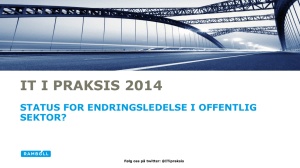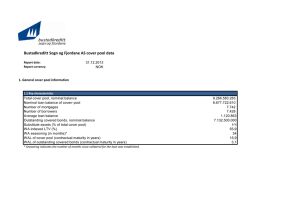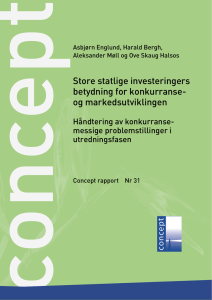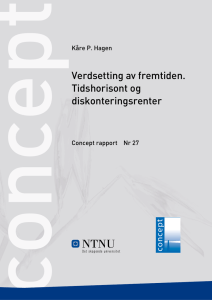Valuing the future. Time horizon and discount rates - Concept
advertisement
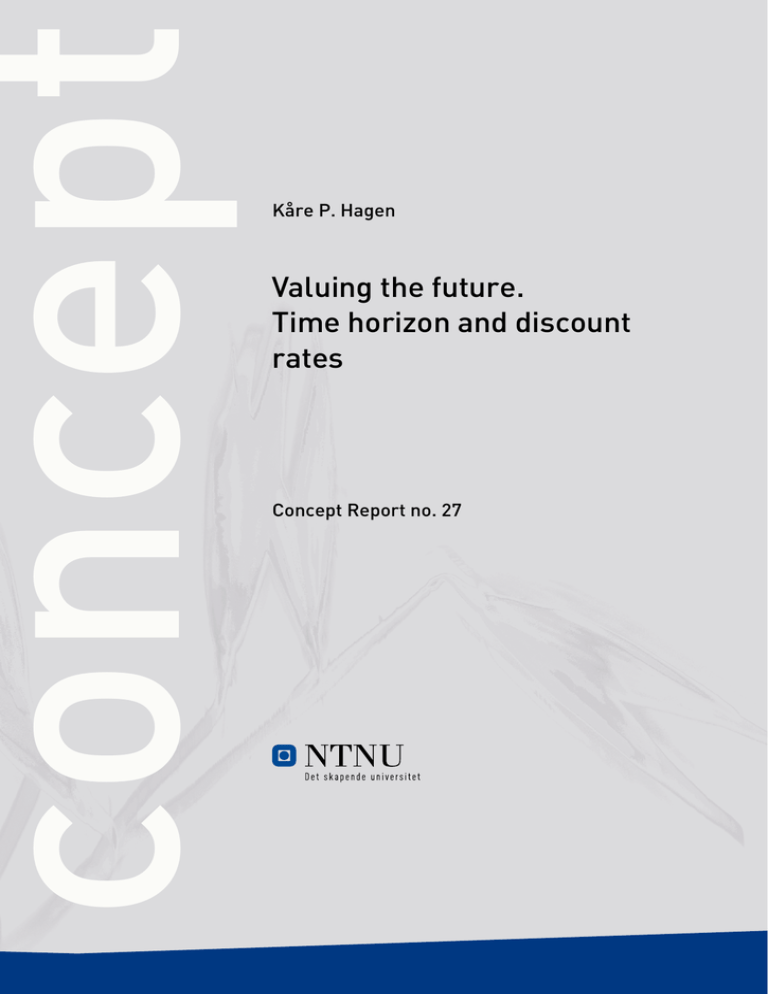
concept Kåre P. Hagen Valuing the future. Time horizon and discount rates Concept Report no. 27 concept Kåre P. Hagen Valuing the future. Time horizon and discount rates Concept Report no. 27 1 © Concept Research Programme 2011 Concept report no. 27 Valuing the future. Time horizon and discount rates Kåre P. Hagen, Professor, Norwegian School of Economics ISSN: 0803-9763 (paper version) ISSN: 0804-5585 (web version) ISBN: 978-82-92506-93-6 (paper version) ISBN: 978-82-92506-94-3 (web version) Date: 27.09.2011 Publisher: Concept Research Programme Norwegian University of Science and Technology 7491 NTNU – Trondheim Norway Tel. +47 73594640 Fax. +47 73597021 www.concept.ntnu.no Responsibility for the information in the reports produced on behalf of the Concept Research Programme is on the commissioned party. Views and conclusions is on account of the authors and not necessarily identical to the views of the Concept Research Programme. Concept report no. 27 2 Summary When performing a cost-benefit analysis of investment projects, it is necessary to compare and evaluate the consequences that occur at different points in time. The normal procedure is to transform estimated future values to present values by using a discount rate. The discount rate is interpreted as the required rate of return reflecting what could obtained if the capital was put to the best alternative use. Traditionally, a constant risk-adjusted rate of return has been used, independent of the project’s time horizon (exponential discounting). This implies that costs and benefits that occur far into the future will have little impact today. For example, environmental efforts and railway infrastructure projects that involve large costs up-front and for which benefits only occur in the long run, will inevitably experience difficulties in achieving a positive net present value. This has been seen as problematic, both from an ethical point of view, bearing in mind future generations, and from an investment point of view, based on considerations of how such risks actually develop. In this study we examine different theoretical models that explain the optimal time profile for the discount rate, and especially we look at factors that may lead to a decreasing discount rate. The optimal level of the discount rate is influenced by the following factors: • • • The macroeconomic development over time and uncertainty related to it Uncertainty about the project’s own contribution to future wealth Decision-makers’ preferences. We focus primarily on uncertainty related to future macroeconomic development, factors that are independent of the project’s own risk profile. The use of a constant rate of return rests on the assumption that growth in welfare (consumption per capita) remains at the same rate, implying that consumption and population increase at the same rate. An expectation of steady growth in consumption per capita over time should imply that the discount rate increases over time, given that there is little need to save for future generations because each generation will be richer. If, on the other hand, there is reason to believe that the growth in wealth will decrease, for example due to resource limitations relative to population growth, the discount rate should decrease over time. An investment can either be financed by postponing consumption or by renouncing other investment alternatives. In the former case, the discount rate is determined by the consumer’s required rate of return, while in the latter case it is determined by the alternative rate of return in the financial market. We show that in both approaches, Concept report no. 27 3 increasing uncertainty (with respect to future consumption or the market’s rate of return) leads to a decreasing optimal discount rate over time. The classical Ramsey model assumes that investment is financed by postponing consumption. Consumers will claim compensation for postponed consumption. It can be deduced that increasing uncertainty with respect to future consumption growth implies a decreasing discount rate. This may be interpreted as precautionary saving. Other models explain the discount rate by the alternative rate of return in the financial market. In these models as well, a decreasing time profile for the discount rate may be derived when future rates of return in the market are uncertain and there is some serial correlation over time. This outcome will hold even when the project’s own rate of return is certain. Towards the end of the report we also discuss another possible explanation for decreasing discount rates, namely when decision-makers have time-dependent (hyperbolic) preferences. This means that their time preferences change over time and that postponing benefits is worse in the short run than in the long run. For example, people may prefer to have one apple today rather than two apples tomorrow, but they still prefer two apples in ten days’ time to one apple in nine days’ time. The problem with hyperbolic preferences is that they may lead to investment decisions that are inconsistent over time. This may explain why good intentions in the long run often do not materialize as concrete efforts in the short run. This can be shown by another example taken from everyday life: ‘I will stop smoking one day, but not today’. Decreasing discount rates over time is often seen as a symptom of hyperbolic preferences. An important aim of this study, however, is to show that decreasing discount rates may also be explained by factors related to macroeconomic development and that this does not necessarily lead to inconsistent decisions. Concept report no. 27 Concept rapportserie Papirtrykk: ISSN 0803-9763 Elektronisk utgave på internett: ISSN 0804-5585 Lastes ned fra: www.concept.ntnu.no/publikasjoner/rapportserie Rapport Tittel Forfatter Nr. 1 Styring av prosjektporteføljer i staten. Usikkerhetsavsetning på porteføljenivå Stein Berntsen og Thorleif Sunde Project Portfolio Management. Estimating Provisions for Uncertainty at Portfolio Level. Nr. 2 Statlig styring av prosjektledelse. Empiri og økonomiske prinsipper. Dag Morten Dalen, Ola Lædre og Christian Riis Economic Incentives in Public Project Management Nr. 3 Beslutningsunderlag og beslutninger i store statlige investeringsprosjekt Stein V. Larsen, Eilif Holte og Sverre Haanæs Decisions and the Basis for Decisions in Major Public Investment Projects Nr. 4 Konseptutvikling og evaluering i store statlige investeringsprosjekt Concept Development and Evaluation in Major Public Investment Projects Nr. 5 Bedre behovsanalyser. Erfaringer og anbefalinger om behovsanalyser i store offentlige investeringsprosjekt Hege Gry Solheim, Erik Dammen, Håvard O. Skaldebø, Eystein Myking, Elisabeth K. Svendsen og Paul Torgersen Petter Næss Needs Analysis in Major Public Investment Projects. Lessons and Recommendations Nr. 6 Målformulering i store statlige investeringsprosjekt Ole Jonny Klakegg Alignment of Objectives in Major Public Investment Projects Nr. 7 Hvordan trur vi at det blir? Effektvurderinger av store offentlige prosjekt Nils Olsson Up-front Conjecture of Anticipated Effects of Major Public Investment Projects Nr. 8 Realopsjoner og fleksibilitet i store offentlige investeringsprosjekt Kjell Arne Brekke Real Options and Flexibility in Major Public Investment Projects Nr. 9 Bedre utforming av store offentlige investeringsprosjekter. Vurdering av behov, mål og effekt i tidligfasen Improved Design of Public Investment Projects. Up-front Appraisal of Needs, Objectives and Effects Nr. 10 Usikkerhetsanalyse – Kontekst og grunnlag Uncertainty Analysis – Context and Foundations Nr. 11 Usikkerhetsanalyse – Modellering, estimering og beregning Uncertainty Analysis – Modeling, Estimation and Calculation Nr. 12 Metoder for usikkerhetsanalyse Uncertainty Analysis – Methodology Petter Næss med bidrag fra Kjell Arne Brekke, Nils Olsson og Ole Jonny Klakegg Kjell Austeng, Olav Torp, Jon Terje Midtbø, Ingemund Jordanger, og Ole Morten Magnussen Frode Drevland, Kjell Austeng og Olav Torp Kjell Austeng, Jon Terje Midtbø, Vidar Helland, Olav Torp og Ingemund Jordanger Concept rapportserie Papirtrykk: ISSN 0803-9763 Elektronisk utgave på internett: ISSN 0804-5585 Lastes ned fra: www.concept.ntnu.no/publikasjoner/rapportserie Rapport Tittel Forfatter Nr. 13 Usikkerhetsanalyse – Feilkilder i metode og beregning Kjell Austeng, Vibeke Binz og Frode Drevland Uncertainty Analysis – Methodological Errors in Data and Analysis Nr. 14 Positiv usikkerhet og økt verdiskaping Ingemund Jordanger Positive Uncertainty and Increasing Return on Investments Nr. 15 Kostnadsusikkerhet i store statlige investeringsprosjekter; Empiriske studier basert på KS2 Cost Uncertainty in Large Public Investment Projects. Empirical Studies Nr. 16 Kontrahering i prosjektets tidligfase. Forsvarets anskaffelser. Olav Torp (red.), Ole Morten Magnussen, Nils Olsson og Ole Jonny Klakegg Erik N. Warberg Procurement in a Project’s Early Phases. Defense Aquisitions Nr. 17 Beslutninger på svakt informasjonsgrunnlag. Tilnærminger og utfordringer i prosjekters tidlige fase Kjell Sunnevåg (red.) Decisions Based on Scant Information. Challenges and Tools During the Front-end Phases of Projects Nr. 18 Flermålsanalyser i store statlige investeringsprosjekt Multi-Criteria Decision Analysis In Major Public Investment Projects Nr. 19 Effektvurdering av store statlige investeringsprosjekter Impact Assessment of Major Public Investment Projects Nr. 20 Investorers vurdering av prosjekters godhet Investors’ Appraisal of Project Feasibility Nr. 21 Logisk minimalisme, rasjonalitet - og de avgjørende valg Major Projects: Logical Minimalism, Rationality and Grand Choices Nr. 22 Miljøøkonomi og samfunnsøkonomisk lønnsomhet Ingemund Jordanger, Stein Malerud, Harald Minken, Arvid Strand Bjørn Andersen, Svein Bråthen, Tom Fagerhaug, Ola Nafstad, Petter Næss og Nils Olsson Nils Olsson, Stein Frydenberg, Erik W. Jakobsen, Svein Arne Jessen, Roger Sørheim og Lillian Waagø Knut Samset, Arvid Strand og Vincent F. Hendricks Kåre P. Hagen Environmental Economics and Economic Viability Nr. 23 The Norwegian Front-End Governance Regime of Major Public Projects – A Theoretically Based Analysis and Evaluation Tom Christensen Nr. 24 Markedsorienterte styringsmetoder i miljøpolitikken Kåre P. Hagen Market oriented approaches to environmental policy Nr. 25 Regime for planlegging og beslutning i sykehusprosjekter Planning and Decision Making in Hospital Projects. Lessons with the Norwegian Governance Scheme. Asmund Myrbostad, Tarald Rohde, Pål Martinussen og Marte Lauvsnes Concept rapportserie Papirtrykk: ISSN 0803-9763 Elektronisk utgave på internett: ISSN 0804-5585 Lastes ned fra: www.concept.ntnu.no/publikasjoner/rapportserie Rapport Tittel Forfatter Nr. 26 Politisk styring, lokal rasjonalitet og komplekse koalisjoner. Tidligfaseprosessen i store offentlige investeringsprosjekter Erik Whist, Tom Christensen Political Control, Local Rationality and Complex Coalitions. Focus on the front-end of large public investment projects Nr. 27 Verdsetting av fremtiden. Tidshorisont og diskonteringsrenter Valuing the future. Time horizon and discount rates Kåre P. Hagen Nasjonalt sertifikat: 1660 Tapir Uttrykk Concept Report no. 27 www.concept.ntnu.no Forskningsprogrammet Concept skal utvikle The Concept research program aims to develop kunnskap som sikrer bedre ressursutnyt- know-how to help make more efficient use of ting og effekt av store, statlige investeringer. resources and improve the effect of major public ­Programmet driver følgeforskning knyttet til de investments. The Program is designed to follow største statlige investeringsprosjektene over en up on the largest public projects over a period of rekke år. En skal trekke erfaringer fra disse som several years, and help improve design and quality kan bedre utformingen og kvalitetssikringen av assurance of future public projects before they are nye investeringsprosjekter før de settes i gang. formally approved. Concept er lokalisert ved Norges teknisk- natur- The program is based at The Norwegian U ­ niversity vitenskapelige universitet i Trondheim (NTNU), of Science and Technology (NTNU), Faculty of ved Fakultet for ingeniørvitenskap og teknologi. Engineering Science and Technology. It cooperates Programmet samarbeider med ledende norske with key Norwegian and international professional og internasjonale fagmiljøer og universiteter, og institutions and universities, and is financed by the er finansiert av Finansdepartementet. Norwegian Ministry of Finance. Address: The Concept Research Program Høgskoleringen 7A N-7491 NTNU Trondheim Tel.: +47 73594670 Fax.: +47 73597021 ISSN: 0803-9763 ISBN: 978-82-92506-93-6 concept NORWAY
